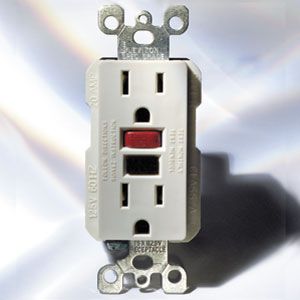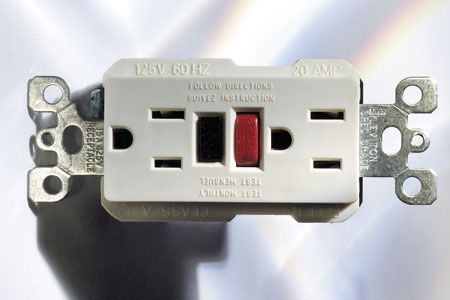
Ground fault circuit interrupter (GFCI) receptacles are safety devices that protect you from electrical shocks in your home. These innovative outlets monitor the flow of electricity and quickly shut off power when they detect a ground fault, potentially saving lives. In this comprehensive guide, we’ll explore how GFCIs work, where they’re required, and why they’re essential for electrical safety in your home.
What Is a Ground Fault?
A ground fault occurs when electricity escapes its intended path in an appliance, light fixture, or power tool and takes a shortcut to the ground. This can happen due to damaged insulation, water exposure, or other factors. When a person becomes part of this unintended path, they can receive a dangerous or even fatal electric shock.
Ground faults often happen without any warning. The insulation around electrical wires can degrade over time, especially in environments exposed to moisture, heat, or other conditions. When this happens, the electricity may seek an alternate path to the ground, potentially through any conductive material—including water and the human body. This scenario shows how important it is to understand and prevent ground faults.
How GFCIs Work
GFCIs work by continuously comparing the amount of current flowing into and out of a circuit. When operating normally, these two currents should be equal. If the GFCI detects a difference of more than 5 milliamps, it quickly interrupts the circuit, cutting off power to prevent potential electrocution.
As Bill Grande, the manager for safety products at Leviton—a manufacturer of GFCIs—explains, “The great thing about GFCIs is that they protect you whether or not your wiring is grounded.” This makes GFCIs an essential safety feature in both new construction and older homes. These devices are particularly effective in bathrooms, kitchens, and other areas where moisture introduces a higher risk of electrical shock.
The Importance of GFCI Protection
GFCI protection is vital for preventing electrical accidents in your home.
Preventing Electrocution
Electrocution is a serious risk in areas where electricity and water may come into contact. GFCIs are designed to react quickly to ground faults, shutting off power in as little as 0.025 seconds. This rapid response can mean the difference between life and death in the event of an electrical accident.
About 200 people in the U.S. die from ground faults each year, accounting for two-thirds of all electrocutions occurring in homes. By installing GFCIs in key areas of your home, you can significantly reduce this risk. Beyond just compliance, having GFCIs in these critical areas provides peace of mind, knowing that your family is safeguarded against these unforeseen electrical hazards.
Reducing Fire Hazards
In addition to protecting against electrocution, GFCIs can help prevent electrical fires. By quickly cutting off power when a ground fault is detected, these devices can stop electrical arcing or overheating before it leads to a fire. This added layer of protection makes GFCIs an essential component of your home’s overall fire safety strategy.
Fire hazards due to electrical issues are more common than many people realize. Compromised insulation, faulty appliances, and other unidentified electrical problems can start fires. Installing GFCIs minimizes this risk, as they act as an immediate barrier, cutting off the power long before it can lead to an ignition. Regular maintenance, paired with GFCI installations, ensures that your home’s electrical system remains safe and functional.
Types of GFCI Devices
There are several types of GFCI devices available to suit different needs and applications.
GFCI Receptacles
GFCI receptacles are the most common type of GFCI protection. These devices replace standard electrical outlets in areas where ground fault protection is required. They feature a test and reset button on the face of the outlet, allowing for easy testing and resetting if the GFCI trips.
These receptacles are especially practical in living spaces frequently used by the whole family, such as kitchens, bathrooms, and play areas. Their test and reset buttons are easily accessible, ensuring quick verification and functionalities. Moreover, many modern GFCI receptacles come with tamper-resistant features, adding another layer of safety.
GFCI Circuit Breakers
GFCI circuit breakers are installed in your main electrical panel and provide protection for an entire circuit. These are particularly useful when you want to protect multiple outlets on the same circuit or when access to individual outlets is limited. However, they can be more expensive than receptacle-type GFCIs—our team found average prices* running as much as $150 for 50-amp models.
Choosing GFCI circuit breakers for comprehensive electrical safety becomes more compelling when considering larger homes. Entire circuit protection ensures that no matter which outlet within that circuit experiences a ground fault, the GFCI breaker will respond promptly, enhancing overall household protection. These breakers also minimize aesthetic disruptions, as the protection mechanism is out of sight, embedded seamlessly in the main panel.
*Unless otherwise noted, prices in this article reflect an average of prices our team found from hardware stores like Lowes and Home Depot, and on Amazon.com.
Portable GFCI Adapters
Portable GFCI adapters are plug-in devices that can be used with standard outlets to provide temporary GFCI protection. These are useful for outdoor work or when using power tools in areas without built-in GFCI protection. Portable GFCI adapters typically cost around $23 to $45.
These adapters excel in providing on-the-go protection. Whether you’re setting up an outdoor workspace or managing an impromptu repair that requires electrical tools, portable GFCI adapters offer a convenient layer of safety. Despite their temporary nature, they provide robust protection, ensuring that any tasks carried out beyond the immediate confines of indoor safety regulations remain risk-free.
Where GFCI Protection Is Required
The National Electric Code (NEC) requires GFCI protection in specific areas of your home where the risk of electrical shock is highest. Let’s look at the indoor and outdoor locations where GFCIs are mandatory. Understanding these requirements ensures that your home complies with regulations and retains the highest safety standards.
Indoor Locations
GFCI protection is required in the following indoor areas:
- Kitchens: All countertop receptacles
- Bathrooms: All receptacles
- Laundry rooms and utility sinks
- Unfinished basements
- Crawl spaces
Indoor locations such as kitchens and bathrooms are particularly vulnerable due to high moisture levels. Laundry rooms and utility sinks also necessitate GFCI protection because of the heavy water usage associated with these spaces. By comprehensively protecting these areas, homeowners can mitigate risks related to frequent contact between water and electricity.
Outdoor Areas
Outdoors, GFCI protection is required for:
- All outdoor receptacles
- Garage and accessory building receptacles
- Receptacles near swimming pools, hot tubs, and spas
Even if your home was built before these requirements were in place, it’s highly recommended to add GFCI protection in these areas for improved safety.
Outdoor environments pose distinctive challenges, primarily due to their exposure to weather elements. GFCI protection in outdoor receptacles, garages, and near swimming areas is vital. These environments often combine moisture with outdoor electrical tools and devices, heightening the risk of ground faults. Proactively installing GFCIs in these locations greatly enhances outdoor electrical safety, ensuring that your family can enjoy these areas without compromising on safety.
Installing and Maintaining GFCIs
Proper installation and maintenance of GFCIs can help ensure their effectiveness. Here’s what you need to know about installing and caring for these devices.
DIY Installation Tips
If you’re comfortable working with electrical systems, you can install GFCI receptacles yourself. Here are some tips:
- Always turn off power at the circuit breaker before beginning work.
- Follow the manufacturer’s instructions carefully.
- Ensure proper wiring connections, especially the line and load terminals.
- Test the GFCI after installation to confirm it’s working correctly.
DIY installation is a feasible option for those who have basic electrical knowledge. Paying close attention to the manufacturer’s guidelines ensures that the GFCI operates as intended. By verifying correct wiring and performing test routines post-installation, you can ensure the device’s efficacy and safeguard against potential malfunctions.
Professional Installation
While GFCI installation can be a DIY project, many homeowners prefer to hire a professional electrician for safety and peace of mind. Professional installations provide an added assurance of quality and compliance, particularly in more complex systems. Moreover, they may uncover additional areas needing protection that you had initially overlooked.
Regular Testing and Maintenance
To ensure your GFCIs are functioning correctly, it’s important to test them regularly. Grande recommends the following monthly test:
- Plug in a light fixture and turn it on.
- Press the GFCI’s test button.
- The light should turn off immediately.
- Press the reset button to restore power.
If the light stays on after pressing the test button, the GFCI needs to be replaced. Incorporating regular testing and maintenance into your household routine ensures that your GFCIs consistently offer the protection they are designed to provide. Electrical surges and lightning strikes can unpredictably damage the internal components of GFCIs. This practice not only verifies functionality but also identifies any potential issues early, allowing for timely replacements.
Common Misconceptions About GFCIs
There are several misconceptions about GFCIs that can lead to confusion about their purpose and functionality. Let’s clear up two common misunderstandings.
GFCIs vs. Surge Protectors
While both devices offer electrical protection, they serve different purposes. GFCIs protect against ground faults and potential electrocution, while surge protectors guard against voltage spikes that can damage electronic devices. It’s important to use both types of protection where appropriate.
Surge protectors and GFCIs work together to offer comprehensive electrical system protection. While a GFCI immediately cuts power to prevent electrocution risks, a surge protector defends against sudden voltage spikes which could destroy sensitive electronic devices. Understanding this distinction ensures that each device is correctly positioned within your home for optimal protective benefits.
Grounding and GFCI Protection
Some people believe that GFCIs only work in grounded circuits, but this is not the case. GFCIs can provide protection even in ungrounded circuits, making them valuable safety devices in older homes that may lack proper grounding. GFCIs can ensure that electrical safety is heightened in older structures, providing peace of mind without the need for expensive re-wiring projects.
Upgrading Older Homes with GFCI Protection
If you live in an older home without GFCI protection, it’s wise to consider upgrading. Here are some options and considerations for retrofitting your home with GFCIs.
Retrofitting Options
There are several ways to add GFCI protection to an older home:
- Replace existing outlets with GFCI receptacles in required areas.
- Install GFCI circuit breakers in the main panel to protect entire circuits.
- Use portable GFCI adapters for temporary protection.
Retrofitting ensures that older homes maintain electrical safety standards comparable to newer buildings. Whether through individual outlet replacements, circuit-wide protections, or portable adaptors, these measures collectively enhance household safety.
Cost Considerations
The cost of upgrading to GFCI protection can vary depending on the method chosen and the number of areas that need protection. Individual GFCI receptacles typically cost around $10 each, while GFCI circuit breakers can range from $100 to $500. While there is an upfront cost, the added safety these devices provide is invaluable.
Deciding on the best approach involves balancing the immediate costs against long-term protection benefits. While retrofitting an entire home may seem expensive, it proves a significant investment toward safeguarding against potential electrical hazards.
GFCI Receptacles: Our Conclusion
GFCI receptacles are essential safety devices that significantly reduce the risk of electrical shock and related accidents in your home. By understanding how they work and where they’re needed, you can ensure your home is properly protected.
Whether you’re building a new home, renovating, or simply looking to improve safety in your current residence, installing GFCIs in key areas is a smart decision. Regular testing and maintenance will help ensure these devices continue to protect you and your family from electrical hazards.

